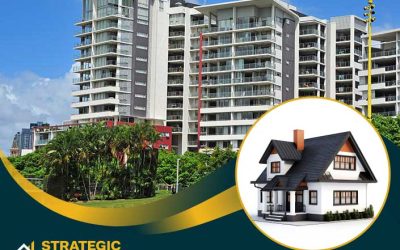
To retire on income from rental properties, the critical question is, ‘How many investment properties do I need?’
This article cuts through the complexity to provide clarity on “how many investment properties to retire” comfortably.
We’ll break down the essentials of aligning investment properties with your retirement goals, ensuring that you can confidently plan for a future of financial independence.
Key Takeaways
- Achieving a comfortable retirement through property investment hinges on setting clear goals based on your desired retirement lifestyle, factoring in annual expenses, and identifying the necessary retirement income needed to sustain that lifestyle.
- A strategic approach to property investment involves selecting high-growth properties, timing the market accurately, balancing cash flow with mortgage debt, and understanding tax implications, with diversification as a key to mitigating risk and enhancing returns.
- As retirement approaches, investors should focus on consolidating their property assets, reducing liabilities, and planning for a sustainable passive income stream from their property portfolio to ensure financial independence and a comfortable standard of living.
Decoding Your Retirement Goals with Investment Properties
 The path to a comfortable retirement begins with setting clear and achievable goals. For property investors, these goals are often tied to acquiring rental properties that can generate a stable income stream. The process of establishing precise retirement objectives involves:
The path to a comfortable retirement begins with setting clear and achievable goals. For property investors, these goals are often tied to acquiring rental properties that can generate a stable income stream. The process of establishing precise retirement objectives involves:
- Assessing your current income and expenses
- Reviewing your retirement savings and investments
- Calculating your retirement income needs
- Defining your goals, such as how many properties you want to acquire
Understanding Your Retirement Lifestyle Aspirations
The journey begins by grasping your retirement lifestyle aspirations. This process entails:
- Gauging the cost of your envisioned retirement lifestyle
- Evaluating your present income and expenditures
- Overviewing retirement savings and investments
- Calculating future expenses.
For example, couples aged 65 to 84 typically require approximately $68,014 per year to sustain a comfortable lifestyle. To support this standard of living, it’s estimated that a couple needs a lump sum of $690,000 at retirement.
Calculating Required Retirement Income
Following this, you need to determine the income needed to sustain your desired lifestyle post retirement. A commonly recommended guideline is to aim for two-thirds (67%) of your pre-retirement income to retire comfortably. This benchmark considers the typical reduction in expenses due to changes in lifestyle after retiring.
Residential real estate investment can serve as a plausible strategy to meet this income objective. It is also crucial to factor in inflation, as it gradually diminishes the purchasing power of money, thereby diminishing the spending capability of your retirement income.
Setting Realistic Property Investment Goals
Having determined the income needed for your envisioned lifestyle, you should now establish your property investment objectives to achieve financial freedom. These should be achievable and based on your retirement income requirements and current financial situation.
For example, some people may aim to own $5 million worth of properties with no mortgage to rely on rental income for a comfortable retirement. However, there is no universal figure, and it is important to take into account personal retirement income needs and financial circumstances.
Crafting Your Property Investment Strategy
 Formulating a comprehensive property investment strategy is essential for optimizing your returns on many investment properties and climbing the property investment ladder. This involves:
Formulating a comprehensive property investment strategy is essential for optimizing your returns on many investment properties and climbing the property investment ladder. This involves:
- Selecting properties with strong potential for capital growth
- Timing your investments to align with market conditions
- Identifying areas with favorable indicators such as proximity to train stations or well-regarded school districts, which often attract higher property prices
By following these steps, you can increase your chances of success in the property market.
A thorough evaluation of these factors coupled with financial metric calculations enables effective estimation of the investment’s future value proposition.
Selecting High Growth Properties
In the selection of high growth properties, factors such as:
- population and employment growth
- infrastructure development
- rental demand
- supply and demand dynamics
- affordability
should be taken into account. Future development plans, including infrastructure improvements, can also have a substantial positive influence on the growth potential of properties by enhancing accessibility and desirability.
Timing the Market for Maximum Gain
Grasping the concept of market timing can considerably influence the success rate of your property investment. This involves attempting to forecast the optimal time to purchase or sell a property by considering current market conditions. By analyzing market trends and indicators, investors can pinpoint profitable investment prospects across various phases of the cycle.
Financial Planning and Property Investment
 Another vital facet of property investment involves maintaining a balance between cash flow, mortgage debt, and tax implications. The income generated from the property is considered as part of your taxable income, in addition to other sources of income, such as your salary. Therefore, investment property income is subject to taxation, similar to any other income you receive.
Another vital facet of property investment involves maintaining a balance between cash flow, mortgage debt, and tax implications. The income generated from the property is considered as part of your taxable income, in addition to other sources of income, such as your salary. Therefore, investment property income is subject to taxation, similar to any other income you receive.
Balancing Cash Flow and Mortgage Debt
Effective management of cash flow and mortgage debt is vital for maintaining financial stability and ensuring long-term success. Mortgage debt can have a positive impact on cash flow in real estate investment. Properties with debt typically experience higher cash flow compared to properties without debt.
Elevated interest rates have the potential to diminish cash flow through heightened loan payments and living expenses, consequently influencing the equilibrium between cash flow and mortgage debt.
The Role of Taxable Income and Negative Gearing
Comprehending the role of taxable income and negative gearing is equally significant. Negative gearing in property investment occurs when an individual borrows funds to invest in a property, and the property’s income, such as rent, is insufficient to cover the expenses, including interest and other costs. This results in a financial loss on the investment, which may be used to offset taxable income, potentially resulting in tax advantages.
Diversification within Your Property Portfolio
 Diversification serves as an additional strategy capable of boosting returns and mitigating risk in your property investments. This involves spreading your investments across various types of properties or locations.
Diversification serves as an additional strategy capable of boosting returns and mitigating risk in your property investments. This involves spreading your investments across various types of properties or locations.
A diversified portfolio provides insulation against the poor performance of a single investment, thereby safeguarding the investor’s assets and potentially improving overall returns.
Geographical Diversification
Geographical diversification involves spreading investments across different regions to minimize risk and maximize returns. When considering geographical diversification, it is crucial to take into account:
- The economic strength of the region
- Political stability
- Market performance
- Currency exchange rates
- Legal issues related to property investment.
Diversifying Tenant Profiles
Diversifying tenant profiles is another aspect of portfolio diversification. This can mitigate risk and increase revenue streams from various property types, thereby creating a more stable and dependable income
Achieving Financial Independence Through Smart Property Investing
 Intelligent property investment can lead to financial freedom. This involves:
Intelligent property investment can lead to financial freedom. This involves:
- Leveraging equity
- Structuring loans to grow your property portfolio
- Using existing property equity to finance additional investments
- Expanding your portfolio by considering how many investment properties to acquire
Leveraging Equity to Grow Your Portfolio
Leveraging equity entails the use of borrowed funds for real estate investment. This allows the investor to control 100% of the assets while only providing a portion of the property’s value as a down payment, with the remaining funds being obtained through a mortgage loan.
Structuring Loans for Long-Term Success
Selecting an appropriate loan structure is vital for backing your long-term property investment objectives. A suitable loan structure can offer flexibility, decrease debt, and optimize cash flow, enabling investors to leverage existing property equity to grow their portfolio.
Assessing Risk and Preparing for the Unexpected
 Property investment comes with its set of risks. Recognizing possible risks and putting into action strategies to safeguard your investments is crucial. These risks could range from natural disasters to market downturns. Therefore, it’s crucial to establish safety buffers and ensure adequate insurance coverage to safeguard your investments.
Property investment comes with its set of risks. Recognizing possible risks and putting into action strategies to safeguard your investments is crucial. These risks could range from natural disasters to market downturns. Therefore, it’s crucial to establish safety buffers and ensure adequate insurance coverage to safeguard your investments.
Building Safety Buffers
Setting up financial safety nets or buffers can aid in covering unforeseen expenses and market fluctuations. These buffers are typically allocated between two to four months of rental income and personal expenses.
Insurance and Protection Strategies
Ensuring adequate insurance coverage is another strategy to protect your property investments. The various categories of insurance available for property investments include:
- Landlord insurance
- Contents insurance
- Income protection insurance
- Hazard and fire insurance
Transitioning from Acquisition to Retirement
 As retirement nears, it becomes essential to shift from property acquisition to generating retirement income. This involves consolidating your property portfolio and reducing liabilities to optimize retirement income.
As retirement nears, it becomes essential to shift from property acquisition to generating retirement income. This involves consolidating your property portfolio and reducing liabilities to optimize retirement income.
Consolidating Assets and Reducing Liabilities
Streamlining your property portfolio and reducing debt can significantly optimize your retirement income.
Consolidating properties can contribute to increased retirement income by generating additional income streams from rental properties and potential capital gains from property sales.
Planning for a Sustainable Retirement Income
Lastly, devising a plan for generating a steady and sustainable passive income post retirement through your property investments is of utmost importance. The average income from property investments for retirees can be influenced by factors such as the number of properties owned and their value.
Summary
Retiring comfortably is not just a dream, but a goal that can be achieved with strategic planning and smart property investment. By setting clear retirement goals, crafting a sound property investment strategy, diversifying your property portfolio, leveraging equity, assessing risks, and preparing for the unexpected, you can transition smoothly from property acquisition to retirement income generation. So start today, and make your retirement the best phase of your life.
Frequently Asked Questions

How many properties do you need to retire comfortably?
To retire comfortably, you will need to own your own home and at least three debt-free rental properties. Having six or more rental properties can further contribute to your comfort in retirement.
How many Australians own 3 properties?
Only 5.81% of investors in Australia own 3 investment properties in the 2020-21 financial year.
How many properties does the average investor own?
On average, most investors own only one or two investment properties. This has been the standard for many years.
How many rental properties for passive income?
You can potentially achieve passive income with five or fewer rental properties. Good luck with your property investing!
How does property investment contribute to retirement goals?
Property investment contributes to retirement goals by generating regular post-work income and potentially serving as a source of income throughout retirement. It can help build long-term wealth and financial security.













